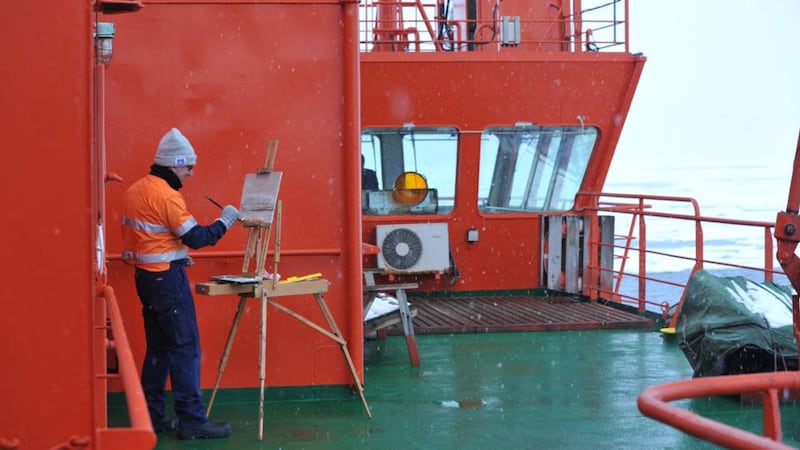'How is one to be creative in the remotest, coldest, windiest and bleakest continent on Earth?" asks Irish-Australian artist John Kelly, who is currently aboard a 6½ ton ice-breaker, the Aurora Australis.
When he's not crossing the Southern Ocean, Kelly lives in Union Hall, west Cork, on a picturesque patch of headland. His recent landscape work, detailing the coastline and inlets of west Cork, is on view at the Oliver Sears Gallery in Dublin.
Kelly’s voyage is taking him to the Antarctic, where he hopes to paint in the open air, in temperatures that can fall as low as -40 degrees.

He will be artist-in-residence with the Australian Antarctic Division on the ice-breaker for the next three months, or perhaps longer, depending on the stubbornness of the ice.
The voyage was made possible through a highly competitive arts bursary, the Antarctic Arts Fellowship. This enables one artist with a non-science focus to experience and engage with the Antarctic first hand.
Lots of white paint
A copy of Herman Melville's Moby-Dick should help pass the time, and Kelly blogs about his experiences when internet access allows. He brought dozens of paintbrushes, 90 canvases of varying sizes, rags and white paint. Lots, and lots, of white paint.
“The first bit of kit they give you is a survival kit,” Kelly says of the preparations for his artistic voyage. “I have all the protective clothing, including balaclavas and gloves, that I’ll need. They then teach you how to get into a survival suit. If I get badly injured, I don’t think I’ll be able to argue much with them. They have doctors on board and so on, but we’ll be in one of the remotest parts of the world. Having said that, they’ve been doing this for 50 years, so I’m as well prepared as I can be.”
Kelly is probably best known for his Cow Up a Tree series of paintings and large sculptures of William Dobell's cows. These were papier-mâché animals used during the second World War to confuse enemy aircraft as to the location of Australian air bases.
Kelly considered how the cows might have appeared after flash floods, and began to work on a series involving the cows, sometimes upside down, hanging out of trees. The sculptures have been exhibited worldwide, from Melbourne to the Champs-Élysées, and more recently in Emmet Place, Cork, as part of a loan agreement with Cork City Council.
All hands on deck
As part of the voyage, Kelly will stay at several Australian stations. Mainly, however, his work is done on the deck of the ship, where he has natural light for almost 24 hours a day. The weather is a major issue, and he is hoping temperatures will warm a little in the coming months from minus 30 or 40 degrees to about minus 15 or 20 degrees.
Part of the scientific mission of the voyage is to drill down into the ice and remove an ice block for scientific analysis. Kelly is sailing with a team of more than 90 personnel.
“I am the only artist on the trip, and what attracts me to it is the idea of confronting the blankness of the Antarctic and my preconceived notion that it is an incredibly white canvas. There is a huge challenge there in how to be creative in such an inhospitable environment.”
'Potential to fail'
The plan is to create at least one painting a day, but given the unpredictability of the trip and the conditions, Kelly may have little control over his artistic output. "It has every potential to fail," he says.
“One artist went there some years ago and slipped and broke her leg early on, and spent most of the time recovering on the ship. It’s not like you can call an ambulance.”
Living in west Cork has reignited his interest in landscape. The Oliver Sears exhibition, Sticks and Stones, is his first major landscape work in several years. There is a sparsity to his recent work, which should help in the Antarctic.
“I reached a point where I began to think that making art in a comfortable studio under fluorescent lights does have limitations,” Kelly says. “Putting yourself into the environment and confronting the world is good for you. I think a lot of contemporary art today doesn’t have that physical feeling of being uncomfortable in yourself behind it.”
The challenge for Kelly artistically in the Antarctic will be the seeming sameness of the environment, as well as its unfriendly nature. But he is looking forward to the perspective that might come with it.
“When you have to paint in front of a landscape that doesn’t care whether you are there or not, like the relentless wind and rain of west Cork, or the cold of the Antarctic, that challenges you artistically. If I get one thing out of this trip, it will probably mean that painting in west Cork will be a doddle from now on.”
John Kelly: Sticks and Stones is at the Oliver Sears Gallery, Dublin, until November 21. Kelly posts regular updates about the voyage on johnkellyartist.com











